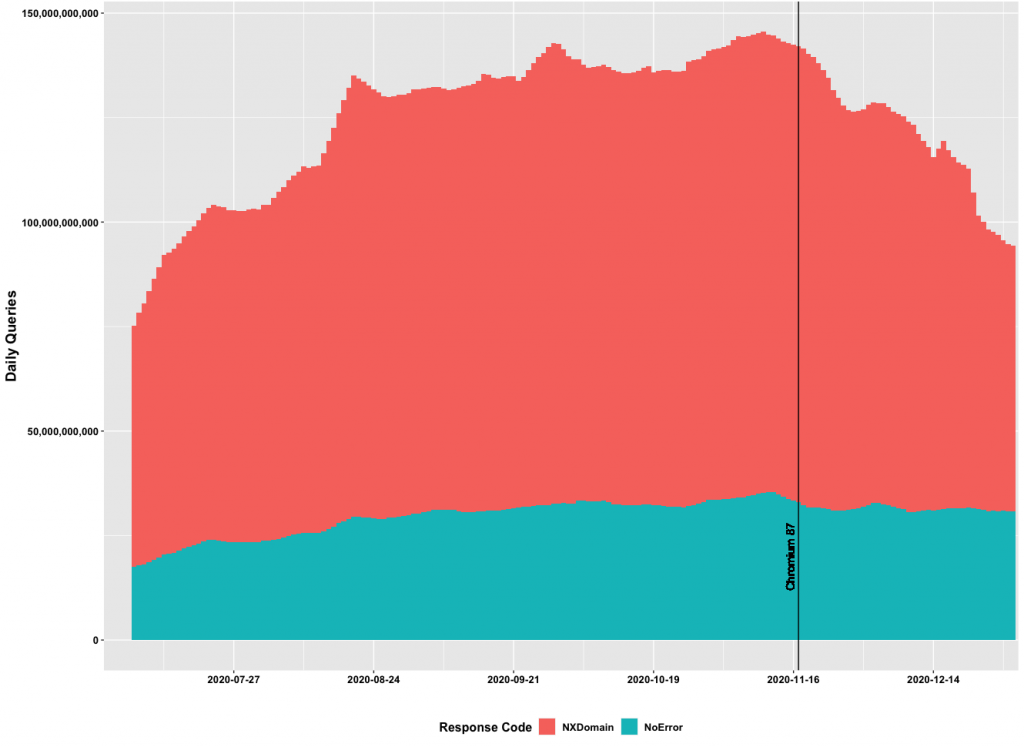
This post is a follow up to Chromium’s Impact on Root DNS traffic, by Matthew Thomas and Duane Wessels.
As we begin a new year, it is important to look back and reflect on our accomplishments and how we can continue to improve. A significant positive the DNS community could take from 2020 is the receptiveness and responsiveness of the Chromium team to address the large amount of DNS queries being sent to the root server system.
In August and September 2020, Verisign quantified that upwards of 45.80% of total DNS traffic to the root servers was, at the time, the result of Chromium intranet redirection detection tests. Since then, the Chromium team has redesigned its code to disable the redirection test on Android systems and introduced a multi-state DNS interception policy that supports disabling the redirection test for desktop browsers. This functionality was released mid-November of 2020 for Android systems in Chromium 87 and, quickly thereafter, the root servers experienced a rapid decline of DNS queries.
The figure below highlights the significant decline of query volume to the root server system immediately after the Chromium 87 release. Before the software release, the root server system saw peaks of ~143 billion queries per day. Traffic volumes have since decreased to ~84 billion queries a day. This represents more than a 41% reduction of total query volume.

This type of broad root system measurement is facilitated by ICANN’s Root Server System Advisory Committee standards document RSSAC002, which establishes a set of baseline metrics for the root server system. These root server metrics are readily available to the public for analysis, monitoring, and research. These metrics represent another milestone the DNS community could appreciate and continue to support and refine going forward.
Rightly noted in ICANN’s Root Name Service Strategy and Implementation publication, the root server system currently “faces growing volumes of traffic” from legitimate users but also from misconfigurations, misuse, and malicious actors and that “the costs incurred by the operators of the root server system continue to climb to mitigate these attacks using the traditional approach”.
As we reflect on how Chromium’s large impact to root server traffic was identified and then resolved, we as a DNS community could consider how outreach and engagement should be incorporated into a traditional approach of addressing DNS security, stability, and resiliency. All too often, technologists solve problems by introducing additional layers of technology abstractions and disregarding simpler solutions, such as outreach and engagement.
Chromium’s efforts show how such outreach and community engagement can have significant impact both to the parties directly involved, and to the broader community. Chromium’s actions will directly aide and ease the operational costs to mitigate attacks at the root. Reducing the root server system load by 41%, with potential further reduction depending on future Chromium deployment decisions, will lighten operational costs incurred to mitigate attacks by relinquishing their computing and network resources.
In pursuit of maintaining a responsible and common-sense root hygiene regimen, Verisign will continue to analyse root telemetry data and engage with entities such as Chromium to highlight operational concerns, just as Verisign has done in the past to address name collisions problems.
This post was originally published on the Verisign blog.
Matthew Thomas contributed to this post.
Duane Wessels is a Distinguished Engineer at Verisign, with a focus on DNSSEC projects and root zone operations.
The views expressed by the authors of this blog are their own and do not necessarily reflect the views of APNIC. Please note a Code of Conduct applies to this blog.

On technical vs. non-technical solutions: it’s very nice this happened, but I’d say this case was exceptionally low-hanging fruit. By that I mean that it was huge impact caused by just a single “party”.
(For community engagement, https://dnsflagday.net comes to mind, but that doesn’t seem easy.)